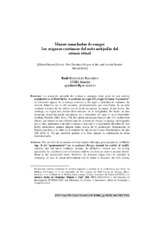Manos manchadas de sangre: los orígenes cristianos del mito antijudío del crimen ritual
Blood-Stained Hands: The Christian Origins of the anti-Jewish Murder Ritual Myth
Autor
González Salinero, Raúl
Editor
Universidad de Córdoba, Servicio de PublicacionesFecha
2013Materia
Crimen ritualMito antijudío
Sócrates Escolástico
Codex Theodosianus, XVI, 8, 18
Purim
Ritual murder
Anti-Jewish Myth
Socrates Scholasticus
METS:
Mostrar el registro METSPREMIS:
Mostrar el registro PREMISMetadatos
Mostrar el registro completo del ítemResumen
La acusación antijudía del crimen o asesinato ritual gozó de una enorme popularidad en la Edad Media. A mediados del siglo XII, surgió de forma “espontánea” en diferentes lugares de la Europa medieval y dio lugar a infinidad de variantes. Su versión definitiva fue la del asesinato, preferentemente por crucifixión, de un niño cristiano a manos de los judíos con el fin de incorporar su sangre al pan ázimo. Sin embargo, su origen más remoto debe buscarse en la Antigüedad. De hecho, su más incipiente desarrollo puede encontrarse ya a comienzos del siglo V en el historiador cristiano Sócrates (Hist. Eccl., VII, 16), quien cuenta que hacia el año 415, en Inmestar (Siria), con motivo de las celebraciones de la fiesta de Purim, los judíos, embriagados por el vino, amarraron a un niño cristiano a una cruz y lo asesinaron. El relato de este hecho monstruoso plantea algunas dudas acerca de lo acontecido. Seguramente la historia sea falsa y se sitúe en el contexto de una ley del Codex Theodosianus del año 408 (XVI, 8, 18) que prohibía insultar a la Cruz durante la celebración de dicha festividad judía. The anti-Jewish accusation of ritual murder did enjoy great popularity in Middle Age. It did “spontaneously” rise in medieval Europe (around the middle of twelfth century) and did know countless variants. Its definitive version was the killing (preferably by crucifixion) of a Christian child by the Jews in order to include his/her blood to the unleavened bread. However, its remotest origin must be searched in Antiquity. In fact, its infant development can be found in Socrates, the fifth-century ecclesiastical historian (Hist. Eccl., VII, 16), who reports that, in the Syrian district of Inmestar around the year 415, some drunked Jews tied a Christian child to a cross on the Purim feast and flogged him to death. This awful account must be sited into the context of a Theodosian constitution (C.Th., XVI, 8, 18, year 408) that did forbid to offend the Cross during the Jewish feasts.

